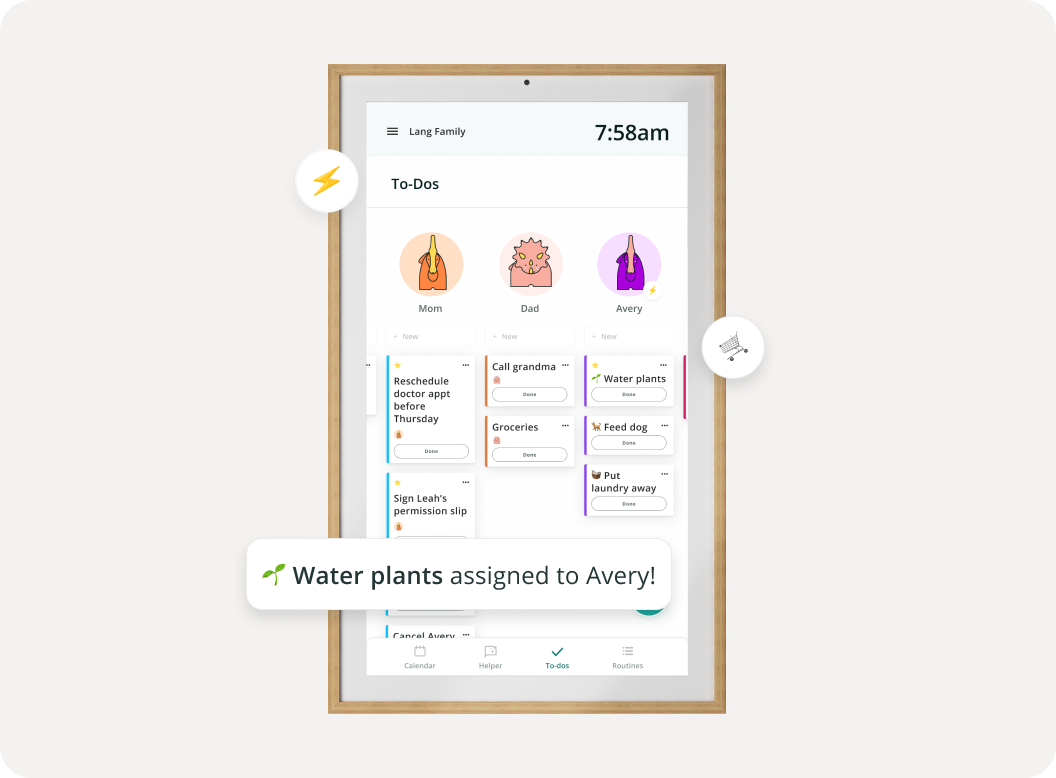Encourage better habits for everyone.
Every household is held together by a to-do list. For some people, it’s scribbled on the back of a receipt. Others might resort to a color-coded system on their desktop. Whatever the method, there’s generally a lack of visibility, building pressure on the list-maker as the keeper of responsibility for the entire family. When plans change, longform lists prove inflexible. Delegating tasks can feel like a part-time job, proving counterintuitive to the involvement you’re trying to encourage in your family members.
Hearth has a solution. By streamlining your household’s to-dos on your Hearth, you can create a central source of truth for all the to-dos in the home.
Here, to-dos become:

Adaptable for different organizational cycles. Create recurring lists that repopulate every day, weekly, or keep things ad-hoc.
Visible to all users in the family. No more copying to-do lists for each person to scatter around the house with hopes they’re seen and completed.
Encouraging of completion on the shared and individual level. When everyone can see how doing their share adds up to overall order, it’s easy to get excited.
Flexible for fixed schedules as well as all of life’s interruptions. Especially with a hand from your Hearth Helper, it's easy to stay on your toes.
Building Blocks for kids’ routines and habits.

To-Dos For Kids Under 5
It’s never too early to create a calming sense of routine in a child’s life. An ongoing to-do list is a simple way to introduce children to autonomy and accomplishment. At this stage, they’re learning so much of what it means to be human by observing and copying what they see. Starting to build out a morning and evening routine can help bookend the day with cues that leave kids feel in control and confident of what’s next. For non-readers, include icons and emojis to help them recognize their to-dos visually. Try keeping things simple by starting with the basics: brushing teeth, getting dressed, eating breakfast. When it’s time to unwind, try a straightforward routine that involves putting on PJs after bath time, choosing books for reading time, and turning the lights out.

To-Dos For Kids Over 5
Managing to-dos for kids over 5 can sometimes feel like an impossible tug-of-war with empty threats and dangled material rewards. The good news is, research shows that when we encourage kids to complete a boring task with empathy, rationale, and non-controlling language, they feel happier completing the task than if rewarded materially. Once morning and evening routines have been cemented and they’ve developed a more concrete sense of time and seasons, it’s a great time to get kids with ongoing household chores. Ideas include: raking the leaves, taking out the trash, helping with dinner prep, caring for pets, and helping set the dinner table.

To-Dos For Adults
A shared, centralized to-do list can be a massive unlock for couples looking alleviate the mental load in their household. As an exercise, the household’s “project manager” might list every task they undertake in a given day in the form of a to-do list. Caregiving tasks, administrative burdens, and personal tasks should all be accounted for. Once listed, try seeing where a partner or outside help might assume responsibility. Instead of managing this balance, use your Hearth’s recurring function to create reminders without the fear of “nagging” or “micromanagement.”
3 Tips For Integrating A To-Do List In Your Family
- Make it fun.
Time to get creative! Utilize emojis. Customize your profile. Get descriptive with the to-do lists you co-create with your kids. And when you’ve crossed off the day’s list, a celebratory dance is always a good idea. - Get everybody involved.
Try to integrate the entire household—including grandparents or caregivers—so that everybody’s on the same team. Keeping a secret to-do list will only make the doubled up work feel harder to maintain. - Working together builds resilience.
Kids are eager to learn. Try brainstorming to-do list items that double as time together. If you love to bake, take time to teach them about carefully measuring ingredients. If you two of you adore the outdoors, why not make gardening a chance to spend time together? Opportunities to co-regulate make children feel calm, connected, and resilient.




